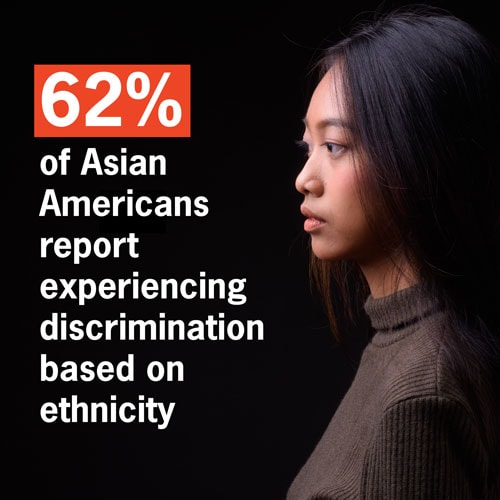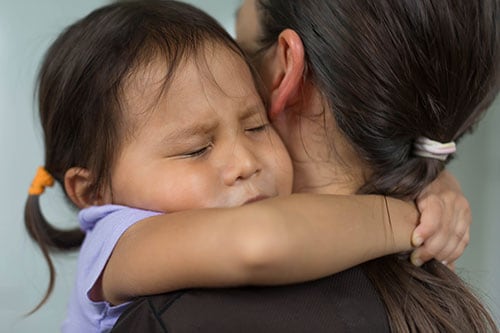Unfair and Unjust Practices and Conditions Harm Asian, Native Hawaiian, and Pacific Islander People and Drive Health Disparities
Some U.S. historical policies and practices have led to mental and physical health risks and challenges, and related long-term health outcomes, for Asian, Native Hawaiian, and Pacific Islander (A/NH/PI) people. For example:
- Discrimination and distress related to immigration laws and policies.6,10
- Colonization of Hawaii, leading to people losing their homes, land, and cultural practices that kept people healthy and well.11,12,13,14
- Refugee resettlement in the U.S. and lasting effects on mental health, health behaviors, and effects on people’s health and quality of life.15
- More and different kinds of commercial tobacco* products coming into the Pacific region after large numbers of people moved in and used commercial tobacco as payment for food products, work, or other goods.16,17
There are also current reasons—like the ones explored below—that help explain why the health of A/NH/PI people is affected by commercial tobacco.
Marketing plays a big role in whether people try or use commercial tobacco products. Commercial tobacco ads make smoking seem more appealing and increases the chance that someone will try smoking for the first time or start using commercial tobacco products regularly.8,18,19
Tobacco companies spend billions of dollars each year to aggressively market their products.20 They also target specific populations, including A/NH/PI populations, with commercial tobacco advertising.21
- Tobacco companies consider Asian people a key group for marketing commercial tobacco products, since cigarette smoking is more prevalent in some Asian countries than in the U.S.18,22

Tobacco companies target cultural events, such as this Dragon Dance celebration for Lunar New Year
- Commercial tobacco ads on billboards and in stores are more common in city neighborhoods with mostly Asian residents than in other city neighborhoods.15
- Tobacco companies promote to Asian American business owners by supporting their business groups and giving them special materials to help drive product sales.15
- Commercial tobacco brands try to appeal to Asian people by making sure their brands are seen, giving money to community organizations, and targeting ads to this group. For example, the tobacco industry has sponsored Lunar New Year festivals and other activities related to Asia/Pacific American Heritage Month.18 The industry has also supported groups serving Asians and others, such as women’s groups, political groups, arts and culture groups, and senior citizens’ groups, with the goal of drawing in Asians and promoting their brands.23
To help protect A/NH/PI people from tobacco marketing and discourage tobacco product use, states and communities can consider increasing prices and prohibiting price discounts, prohibiting the sale of flavored tobacco products, and either allowing fewer stores in a neighborhood to sell commercial tobacco products or prohibiting tobacco product sales altogether.24
Menthol has a minty flavor that masks the harsh taste of tobacco. Menthol makes cigarette smoke feel easier to inhale and can make it harder to quit smoking.25,26,27 Tobacco companies have aggressively marketed menthol cigarettes to A/NH/PI people for decades and continue to do so today.
- The tobacco industry targets neighborhoods with more Asian residents, other communities of color, low-income neighborhoods, and youth with menthol advertising.28
- In 2019, 77% of NH/PI and 41% of Asian adults who smoked reported using a menthol brand, compared to 30% of white people who smoked.29
- In 2011, over half of Asian youth aged 12-17 who smoked reported using a menthol brand—second only to that of Black youth (72%).30
- Filipino and Native Hawaiian/Pacific Islander adults who smoke are more likely to use menthol cigarettes than other groups of Asian adults.31
There are actions states and communities could take to reduce the availability of flavored commercial tobacco products.8,32 For example, prohibiting the sale of all flavors in tobacco products, including cigarettes, e-cigarettes, cigars, and cigarillos, could help to reduce the number of youth who use these products.33

Stress, such as that caused by financial problems, discrimination, or unsafe neighborhoods, can make someone more likely to smoke.34,35,36 Some A/NH/PI people face many types of stress:
- Asian people who reported many instances of discrimination were more likely to smoke than Asian people who reported fewer instances of discrimination.37
- Compared to other racial/ethnic groups, Native Hawaiians are more likely to have low-paying jobs and to have below average living conditions. Many report high levels of racism and discrimination, and that it affects their jobs, housing, and income.38
- Southeast Asian ethnic groups have lower incomes than the average U.S. household income, according to the Southeast Asia Resource Action Center.39 Continuing financial problems are a major source of stress.
When people experience severe or long-lasting forms of stress, their bodies respond by raising stress hormones and keeping them raised. When this goes on for a long time, they may develop health problems like high blood pressure and diabetes.40,41 Smoking cigarettes also leads to disease and disability and harms nearly every organ of the body.8
- Creamer MR, Wang TW, Babb S, et al. Tobacco Product Use and Cessation Indicators Among Adults – United States, 2018 [PDF – 218 KB]. Morbidity and Mortality Weekly Report 2019, 68(45);1013-1019 [accessed 2021 Jan 04].
- Substance Abuse and Mental Health Services Administration. Results from the 2018 National Survey on Drug Use and Health: Detailed Tables. Table 2.12B-Cigarette use in Past Year among Persons Aged 12 or Older, by Age Group and Demographic Characteristics Percentages, 2018 and 2019: Rockville, MD: Substance Abuse and Mental Health Services (SAMHSA), 2019 [accessed 2021 Jan 04].
- Odani S, Armour BS, Agaku IT. Racial/Ethnic Disparities in Tobacco Product Use Among Middle and High School Students — United States, 2014–2017. MMWR Morb Mortal Wkly Rep 2018; 67:952–957 [accessed 2021 Jan 06].
- Mattingly DT, Hirschtick JL, and Fleischer NL. Unpacking the Non-Hispanic Other Category: Differences in Patterns of Tobacco Product Use Among Youth and Adults in the United States, 2009–2018. J Immigrant and Minority Health 2020; 22:1368-72 [accessed 2021 Jan 04].
- Martell BN, Garrett BE, Caraballo RS. Disparities in Adult Cigarette Smoking — United States, 2002–2005 and 2010–2013. MMWR Morb Mortal Wkly Rep 2016;65: 753–758 [accessed 2021 Jan 04].
- Centers for Disease Control and Prevention. Disparities in Adult Cigarette Smoking—United States, 2002-2005 and 2010-2013. Morbidity and Mortality Weekly Report 2016;65(30) [accessed 2021 Feb 03].
- Heron M. Deaths: Leading causes for 2018. Natl Vital Stat Rep 2021;70(4):1–115 [accessed 2022 May 25].
- U.S. Department of Health and Human Services. The Health Consequences of Smoking: 50 Years of Progress. A Report of the Surgeon General. Atlanta, GA: U.S. Department of Health and Human Services, Centers for Disease Control and Prevention, National Center for Chronic Disease Prevention and Health Promotion, Office on Smoking and Health, 2014 [accessed 2022 May 25].
- Islami F, Ward EM, Sung H, et al. Annual report to the Nation on the status of cancer, part 1: National Cancer Statistics [published online ahead of print, 2021 Jul 8]. J Natl Cancer Inst 2021;113(12):1648–1669 [accessed 2022 May 25].
- Yoo HC, Gee GC, Takeuchi D. Discrimination and health among Asian American immigrants: disentangling racial from language discrimination [PDF – 140 KB]. Soc Sci Med 2009;68(4): 726-32 [accessed 2021 Jan 04].
- Merry SE. Colonizing Hawai’i: The Cultural Power of Law. Princeton: Princeton University Press, 2000 [accessed 2020 Dec 08].
- U.S. Department of Housing and Urban Development. Office of Policy Development and Research. Housing Needs of Native Hawaiians: A Report From the Assessment of American Indian, Alaska Native, and Native Hawaiian Housing [PDF – 6.2 MB]. 2017 [accessed 2021 Feb 16].
- Department of Hawaiian Homelands. Text of the Hawaiian Homes Commission Act, 1920 [PDF – 567 KB] [accessed 2021 Feb 16].
- Herman RDK. Out of State, Out of Mind, Out of Power: Leprosy, Race, and Colonization in Hawai’i [PDF – 2.9 MB]. Multidisciplinary Research on Hawaiian Well-Being 2010;6: 265-291 [accessed 2021 Feb 16].
- Fazel M, Wheeler J, Danesh J. Prevalence of serious mental disorder in 7000 refugees resettled in Western countries: a systematic review. [PDF – 92 KB] Lancet. 2005;365(9467):1309–14 [accessed 2021 Jan 04].
- Marshall M. Drinking Smoke: The Tobacco Syndemic in Oceania. University of Hawai’i Press, 2013 [accessed 2020 Dec 09].
- Linhart C, Naseri T, Lin S, Taylor R, Morrell, et al. Tobacco smoking trends in Samoa over four decades: can continued globalization rectify that which it has wrought? Global Health, 2017;13: 31 [accessed 2021 Feb 16].
- Carson NJ, Rodriguez D, Audrain-McGovern J. Investigation of mechanisms linking media exposure to smoking in high school students [PDF – 92 KB]. Prev Med 2005;41(2): 511-20 [accessed 2021 Jan 04].
- Charlesworth A & Glantz SA. Smoking in the movies increases adolescent smoking: A review [PDF – 270 KB]. Pediatrics 2005;116(6): 1516-28 [accessed 2020 Dec 08].
- Federal Trade Commission. Federal Trade Commission Cigarette Report for 2019 [PDF – 1 MB]. Federal Trade Commission, 2021 [accessed 2022 March 2].
- Cruz TB, Rose SW, Lienemann BA, et al. Pro-tobacco marketing and anti-tobacco campaigns aimed at vulnerable populations: A review of the literature. Tob Induc Dis 2019;17:68 [accessed 25 May 2022].
- U.S. Department of Health and Human Services. Tobacco Use Among U.S. Racial/Ethnic Minority Groups—African Americans, American Indians and Alaska Natives, Asian Americans and Pacific Islanders, Hispanics: A Report of the Surgeon General [PDF – 64 MB]. Atlanta: U.S. Department of Health and Human Services, Centers for Disease Control and Prevention, National Center for Chronic Disease Prevention and Health Promotion, Office on Smoking and Health, 1998 [accessed 2021 Jan 04].
- Muggli ME, Pollay RW, Lew R, et al. Targeting of Asian Americans and Pacific Islanders by the tobacco industry: results from the Minnesota Tobacco Document Depository [PDF – 156 KB]. Tob Control 2002;11: 201-209 [accessed 2021 Jan 04].
- Robertson L, McGee R, Marsh L, & Hoek J. A systematic review on the impact of point-of-sale tobacco promotion on smoking [PDF – 602 KB]. Nicotine Tob Res 2015;17(1): 2-17 [accessed 2021 Jan 04].
- Ton HT, Smart AE, Aguilar BL, et al. Menthol enhances the desensitization of human alpha3beta4 nicotinic acetylcholine receptors. Mol Pharmacol 2015 [602 KB];88(2):256-64 [accessed 2020 Jan 06].
- Oliver AJ, Jensen JA, Vogel RI, Anderson AJ, Hatsukami DK. Flavored and nonflavored smokeless tobacco products: Rate, pattern of use, and effects. Nicotine Tob Res 2013;15(1): 88-92 [ accessed 2020 Dec 08].
- Tobacco Products Scientific Advisory Committee. Preliminary scientific evaluation of the possible health effects of menthol versus nonmenthol cigarettes. Rockville, MD: US Department of Health and Human Services, Food and Drug Administration, 2011 [accessed 2020 Dec 08].
- Widome, R., Brock, B., Noble, P., & Forster, J. L. (2013). The relationship of neighborhood demographic characteristics to point-of-sale tobacco advertising and marketing. Ethnicity & health, 18(2), 136-151 [accessed 2021 Jan 06].
- Substance Abuse and Mental Health Services Administration. National Survey on Drug Use and Health. Center for Behavioral Health Statistics and Quality, Substance Abuse & Mental Health Data Archive, 2019 [accessed 2022 May 25].
- Caraballo RS, Asman K. Epidemiology of menthol cigarette use in the United States. Tobac Induc Dis 2011;9(S1):S1 [accessed 2022 May 25].
- Mukherjea A, Wackowski OA, Lee YO, & Delnevo CD. Asian American, Native Hawaiian and Pacific Islander tobacco use patterns [PDF – 347 KB]. Am J Health Behavior 2014;38(3): 362–369 [accessed 2021 Jan 04].
- Office of the U.S. Surgeon General. Surgeon General’s Advisory on E-Cigarette Use Among Youth [PDF – 582 KB]. Atlanta, GA: Centers for Disease Control and Prevention, 2018 [accessed 2021 Feb 16].
- Harrell MB, Loukas A, Jackson CD, Marti CN, & Perry CL. Flavored tobacco product use among youth and young adults: what if flavors didn’t exist? [PDF – 76 KB]Tobac Regulatory Sci 2017;3(2): 168-173 [accessed 2020 Dec 08].
- Slopen N, Dutra LM, Williams DR, et al. Psychosocial stressors and cigarette smoking among African American adults in midlife. [PDF – 233 KB] Nicotine Tob Res. 2012;14(10):1161-1169 [accessed 2020 Dec 08].
- Slopen N, Kontos EZ, Ryff CD, Ayanian JZ, Albert MA, Williams DR. Psychosocial stress and cigarette smoking persistence, cessation, and relapse over 9-10 years: A prospective study of middle-aged adults in the United States. Cancer Causes Control 2013;24(10):1849–1863 [accessed 25 May 2022].
- Purnell JQ, Peppone LJ, Alcaraz K, et al. Perceived discrimination, psychological distress, and current smoking status: Results from the Behavioral Risk Factor Surveillance System Reactions to Race module, 2004–2008. Am J Public Health 2012;102(5):844–851 [accessed 25 May 2022]
- Chae DH, Takeuchi DT, Barbeau EM, Bennett GJ, Lindsey J, & Krieger N. Unfair treatment, racial/ethnic discrimination, ethnic identification, and smoking among Asian Americans in the National Latino and Asian American Study. Am J Public Health 2008;98(3): 485-492 [accessed 2020 Dec 08].
- Kaholokula JK, Grandinetti A, Keller S, Nacapoy AH, Kingi TK, & Mau MK. Association between perceived racism and physiological stress indices in Native Hawaiians. J Behavioral Med 2012;35(1): 27–37 [accessed 2020 Dec 08].
- Asian Americans Advancing Justice. Southeast Asian American Journeys: A National Snapshot of Our Communities [PDF – 9.2 MB]. 2020 [accessed 2020 Dec 08].
- Juster RP, McEwen BS, & Lupien SJ. Allostatic load biomarkers of chronic stress and impact on health and cognition [PDF – 589 KB]. Neuroscience & Biobehavioral Reviews 2010;35(1): 2-16 [accessed 2020 Dec 08].
- Guyll M, Matthews KA, & Bromberger JT. Discrimination and unfair treatment: relationship to cardiovascular reactivity among African American and European American women. Health Psychology 2001;20(5): 315 [accessed 2020 Dec 08].
- Babb S, Malarcher A, Schauer G, Asman K, Jamal A. Quitting Smoking Among Adults — United States, 2000–2015. MMWR, 2017;65(52):1457-64 [accessed 2021 Jan 4].
- U.S. Department of Health and Human Services. Smoking Cessation: A Report of the Surgeon General [PDF – 10 MB]. Centers for Disease Control and Prevention, 2020 [accessed 2021 Jan 04].
- Cox, L. S., Okuyemi, K., Choi, W. S., Ahluwalia, J. S. (2011). A review of tobacco use treatments in U.S. ethnic minority populations. American Journal of Health Promotion, 25(5), S30-S30 [accessed 2021 Jan 28].
- Hooper MW, Payne M, and Parkinson KA. Tobacco cessation pharmacotherapy use among racial/ethnic minorities in the United States: Considerations for primary care [PDF – 936 KB]. Family Medicine and Community Health, 2018(5): 193-203 [accessed 2021 Jan 28].
- Kuiper N, Zhang L, Lee J, Babb SD, Anderson CM, Shannon C, et al. A National Asian-Language Smokers’ Quitline–United States, 2012-2014. Prev Chronic Dis 2015;12:E99 [accessed 2020 Dec 08].
- DiGiulio A, Jump Z, Babb S, et al. State Medicaid Coverage for Tobacco Cessation Treatments and Barriers to Accessing Treatments — United States, 2008–2018. MMWR Morb Mortal Wkly Rep 2020;69:155–160 [accessed 2022 May 25].



